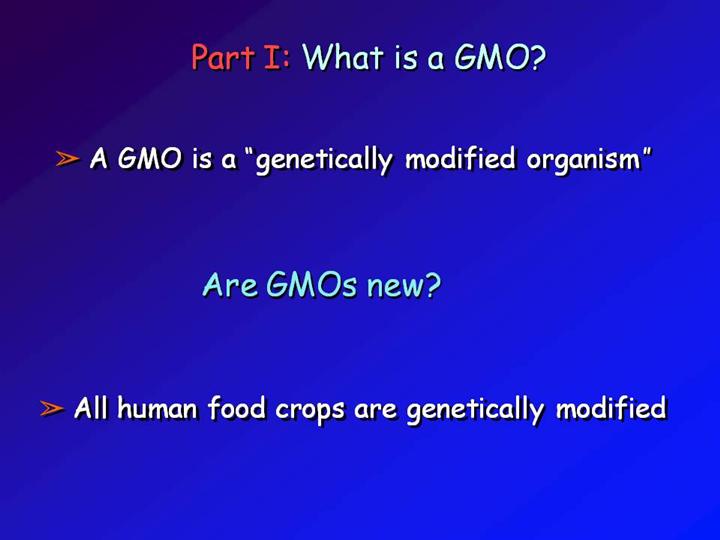 |
Let’s start with
definitions: what is a genetically modified organism” or GMO?
GM means
“genetically modified,” and O means “organism”, which is a living
creature. GMO is most commonly applied to crop
plants, which are plants people grow for food, and it means a crop plant
whose genes have been modified. Genes are the stuff of heredity, of
inhereitance. They’re what provide the information that for a couple to
have a baby (not a chick or a kitten) and for corn kernels grow into corn
plants, not rice or wheat plants. Is genetic modification of crop plants
new? The answer is a NO! People have been genetically modifying plants to
make them into food plants for thousands and thousands -- and thousands of
years. The best guess is that people have been at it for somewhere between
10,000 and perhaps 50,000 years. And if you just give a moment’s thought to
the difference between a dandelion and a corn plant, you’ll say, “of
course!” Wild plants use all kinds of tricks to spread their seeds far and
wide. Dandelions launch their seeds on little parachutes that float in the
wind. Other kinds of plants produce seeds surrounded by tenacious hooks --
we call them “burrs” -- that get caught in an animal’s fur as it races by,
taking the seed far away. All wild plants have some way to scatter their
seeds far from the mother plant and to survive intact, should some bird or
animal eat the seed. So the seeds are generally pretty tough, some even as
hard as rock. But for people to collect plant seeds (we call them grain),
the seeds have to stick to the plant until we come along to harvest the
seeds. So among the first traits that people modified was the tendency of
seeds to scatter. But did people really do the modifying way back then?
Plant genes and genomes -- that’s the set of all the plant’s genes -- are
constantly changing or mutating (the technical term for a genetic change is
a “mutation”). Mutations happen because of the very chemical nature of the
genetic material, called DNA (deoxyribonucleic acid), and the complex
protein machinery that maintains it in chromosomes and copies it when cells
divide.
So genetic
modification (GM) is hardly new -- it’s happening all the time. Most
mutations are not good for organisms, but some mutations are. A mutation,
for example, that keeps seeds stuck to a plant are hardly good for spreading
that plant’s seeds far and wide -- but it’s just the thing that makes a
plant begin to be useful as a food plant for people. |
